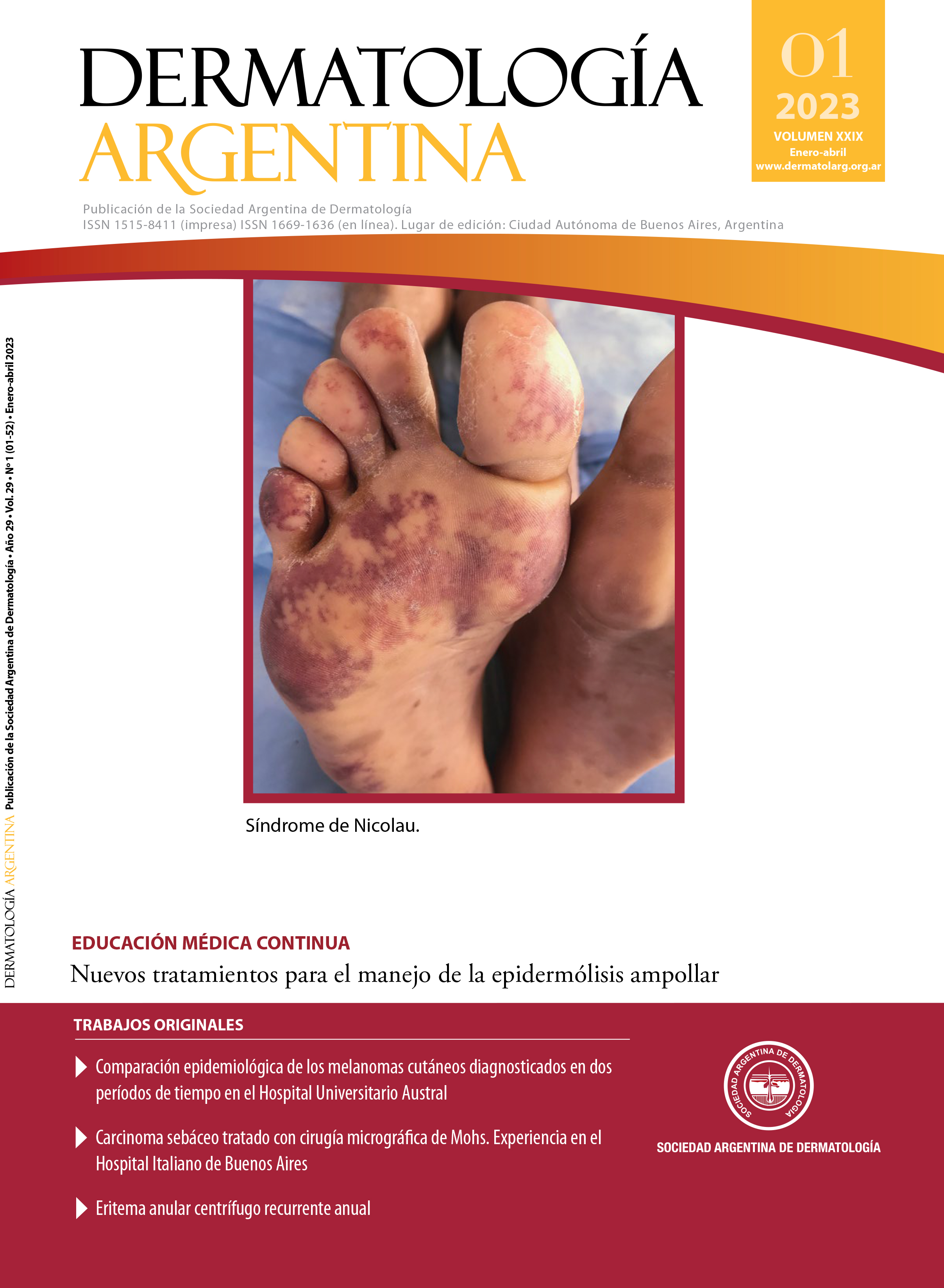Epidemiological comparison of cutaneous melanomas diagnosed in two periods in Hospital Universitario Austral
DOI:
https://doi.org/10.47196/da.v29i1.2335Keywords:
melanoma, epidemiology, diagnosisAbstract
Background: an epidemiological comparison was made between patients diagnosed with cutaneous melanoma (CM) at Hospital Universitario Austral (HUA) in two time periods.
Objectives: to know the epidemiological profile of the patients in our hospital, compare these characteristics in both populations and if there are differences at the time of diagnosis.
Materials and methods: CM that were diagnosed during period A (2000-2008) and period B (2009-2021) were evaluated. Both were compared in terms of the following variables: sex, age, melanoma location, histological subtype, tumor thickness, and ulceration.
Results: 578 CM diagnosed by dermatologists at our center were included. A slight male predominance was observed in both groups (56.5% in period A vs. 55.7% in period B). The average age at diagnosis was 51.42 +/- 1.77 years and 54.54 +/- 0.78 years, respectively. The most frequent location was on the trunk (44.4% vs. 46.6%, respectively). Superficial extensive melanoma was the most frequent subtype (62.8% vs. 64.4%, respectively). The median tumor thickness at diagnosis was 0.65 mm in period A and 0.90 mm in period B. In period A 15% of the CMs presented ulceration, while in period B it was 9%. No significant differences were observed.
Conclusions: we did not find differences between the two periods, as we would have expected given the greater diffusion of skin cancer prevention campaigns and the more widespread use of diagnostic tools.
References
I. Garbe C, Bauer J. Melanoma, en Bolognia JL, Schaffer JV, Cerroni L. 4ª ed. Dermatología. España: Elsevier 2019:1989-2019.
II. Santos R, Gonzalez A, Casas J, Mazzucco J, et ál. Consenso nacional intersociedades sobre melanoma cutáneo. SAD 2011. Disponible en: www.sad.org.ar
III. Dennis LK. Cumulative Sun Exposure and Melanoma in a Population-Based Case-Control Study: Does Sun Sensitivity Matter? Cancers (Basel). 2022;14:1008.
IV. Swetter SM, Thompson JA, Albertini MR, Barker CA, et ál. Melanoma: cutaneous. NCCN Clinical Practice Guidelines in Oncology. 2022. Disponible en: NCCN.org
V. Del Marmol V. Prevention and screening of melanoma in Europe: 20 years of the Euromelanoma campaign. J Eur Acad Dermatol Venereol. 2022;36 Suppl 6:5-11.
VI. Argenziano G, Albertini G, Castagnetti F, De Pace B, et ál. Early diagnosis of melanoma: what is the impact of dermoscopy? Dermatol Ther. 2012; 25:403-409.
VII. Lallas A, Longo C, Manfredini M, Benati E et ál. Accuracy of Dermoscopic Criteria for the diagnosis of melanoma in situ. JAMA Dermatol. 2018;154:414-419.
VIII. Polesie S, Jergéus E, Gillstedt M, Ceder H, et ál. Can Dermoscopy Be Used to Predict if a Melanoma Is In Situ or Invasive? Dermatol Pract Concept. 2021;11:e2021079.
IX. Valdez R, Bonavía P, Busso C, Stringa O. Comparación epidemiológica de los casos de melanoma maligno del Hospital Universitario Austral (HUA) vs. el Registro Argentino de Melanoma Cutáneo (RAMC). Dermatol Argent. 2010;16:34-38.
X. Welch HG, Mazer BL, Adamson AS. The Rapid Rise in Cutaneous Melanoma Diagnoses. N Engl J Med. 2021;384:72-79.
XI. Campaña Nacional de Prevención del Cáncer de Piel. Sociedad Argentina de Dermatología. Disponible en: https://www.cancerdepiel.org.ar/
XII. Conte S, Ghazawi FM, Le M, Nedjar H et ál. Population-Based Study Detailing Cutaneous Melanoma Incidence and Mortality Trends in Canada. Front Med (Lausanne). 2022;9:830254.
XIII. Rosés-Gibert P, Podlipnik S, de la Torre Gomar FJ, Saenz Aguirre A, et ál. Incidence of Melanoma in the Basque Province of Álava, Spain, From 2015 to 2018: A Descriptive Study. Actas Dermosifiliogr. 2022;113:178-182.
XIV. Amarillo D, De Boni D, Nantes F, Tambasco C, et ál. Melanoma cutáneo en Uruguay: características clínico-epidemiológicas y sobrevida en cohorte de pacientes de dos centros de referencia en el período 2008-2017. Rev Med Urug. 2020;36:146-154.
XV. Estadística local de la población del Municipio de Pilar. 2018. Disponible en: https://www.pilar.gov.ar/estadistica/poblacion/
XVI. Grau-Pérez M, Borrego L, Carretero G, Almeida P, et ál. Assessing the effect of environmental and socio-economic factors on skin melanoma incidence: an island-wide spatial study in Gran Canaria (Spain), 2007-2018. Cancer Causes Control. 2022;33:1261-1272.
XVII. Berman-Rosa M, Logan J, Ghazawi FM, Le M, et ál. Analysis of Geographic and Environmental Factors and Their Association with Cutaneous Melanoma Incidence in Canada. Dermatology. 2022:1-12.
XVIII. Buja A, Rugge M, De Luca G, Bovo E, et ál. Cutaneous Melanoma in Alpine Population: Incidence Trends and Clinicopathological Profile. Curr Oncol. 2022; 29:2165-2173.
XIX. Garbe C, Amaral T, Peris K, Hauschild A, et ál. European consensus-based interdisciplinary guideline for melanoma. Part 1: Diagnostics: Update 2022. Eur J Cancer. 2022;170:236-255.
Downloads
Published
Issue
Section
License
Copyright (c) 2023 on behalf of the authors. Reproduction rights: Argentine Society of Dermatology

This work is licensed under a Creative Commons Attribution-NonCommercial-NoDerivatives 4.0 International License.
El/los autor/es tranfieren todos los derechos de autor del manuscrito arriba mencionado a Dermatología Argentina en el caso de que el trabajo sea publicado. El/los autor/es declaran que el artículo es original, que no infringe ningún derecho de propiedad intelectual u otros derechos de terceros, que no se encuentra bajo consideración de otra revista y que no ha sido previamente publicado.
Le solicitamos haga click aquí para imprimir, firmar y enviar por correo postal la transferencia de los derechos de autor












